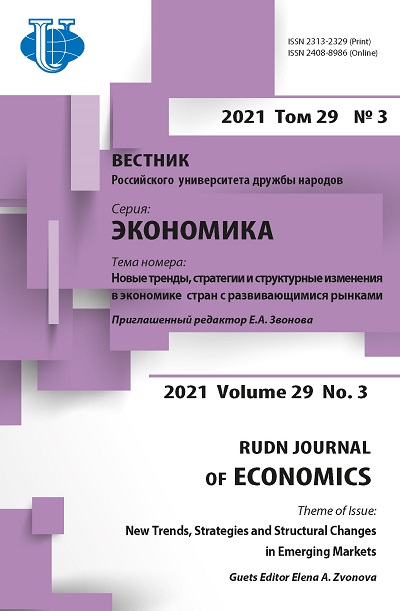Belarus’ external debt in the context of the pandemic and ways to resolve it
- Authors: Gracheva A.D.1, Miroshina E.A.1
-
Affiliations:
- Financial University under the Government of the Russian Federation
- Issue: Vol 29, No 3 (2021): New trends, strategies and structural changes in emerging markets
- Pages: 479-489
- Section: WORLD CAPITAL MARKET
- URL: https://journals.rudn.ru/economics/article/view/27605
- DOI: https://doi.org/10.22363/2313-2329-2021-29-3-479-489
Cite item
Full Text
Abstract
The changes in the amount of the external debt of Belarus depending on various factors are analyzed. The study found that the consequences of the epidemic COVID-19 had a significant impact on the increase in the amount of external debt. In addition, political protests against the government have a special weight in the reasons for the growth of Belarus’ external debt, since their consequences significantly reduced the level of confidence on the part of foreign investors, which led to a fall in the ruble. The role of foreign countries as the main creditors in the external debt of Belarus, as well as in the economy of Belarus as a whole is examined, and the importance of the Belarusian “friendship” with Russia is considered. In conclusion, an assessment of the structure of the Belarusian economy and methods of its regulation is carried out, and then possible ways of settling the Belarusian debt are presented.
About the authors
Anna D. Gracheva
Financial University under the Government of the Russian Federation
Author for correspondence.
Email: ann.gracheva05.12@gmail.com
student, Faculty of Economics and Business
49 Leningradskii Prospekt, Moscow, 125993, Russian FederationElena A. Miroshina
Financial University under the Government of the Russian Federation
Email: easila@yandex.ru
Candidate of Economic Sciences, Associate Professor, Faculty of International Economic Relations
49 Leningradskii Prospekt, Moscow, 125993, Russian FederationReferences
- Ananyeva, M.V., & Natalukha, S.N. (2019). Budget deficit and public debt: Ways to overcome it. Economics and Business: Theory and Practice, (7), 8–10. (In Russ.) http://dx.doi.org/10.24411/2411-0450-2019-11065
- Glazyev, S.Yu. (2020). Belarusian choice. Eurasian Integration: Economics, Law, Politics, 3(33), 11–25. (In Russ.) http://dx.doi.org/10.22394/2073-2929-2020-3-11-25
- Gulyaeva, O.S., & Umanskaya, V.G. (2016). State debt: The essence, consequences and the possibility of repayment. Economic Bulletin of the University, (29–1), 222–229. (In Russ.)
- Koloda, S.A., Epstein, V.A., & Vilchinsky, A.S. (2019). Bilateral relations of Russia and Belarus at the present stage. The World of Russian-Speaking Countries, 2(2), 44–53. (In Russ.) http://dx.doi.org/10.24411/2658-7866-2019-10005.
- Lutskaya, E.E. (2019). The financial system of Belarus: problems and prospects of development. Social and Humanitarian Sciences. Domestic and Foreign Literature. Series 2: Economics, (3), 111–116. (In Russ.)
- Panyusko, A.S. (2020). The impact of the COVID-19 pandemic on the economy of the Republic of Belarus and the economy of developed countries. Archivarius, 4(49), 55–56. (In Russ.)
- Popkova, A.S. (2011). Analysis of the gross external debt of Belarus on the basis of the country’s balance of payments data. Bulletin of the Polotsk State University. Series D: Economic and Legal Sciences, (5), 9–17. (In Russ.)
- Popov, N.E. (2019). Mechanisms of problem debt settlement. Innovations and Investments, (12), 161–164. (In Russ.)















